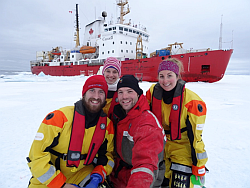
The CCGS Amundsen
In search of multi-year sea ice
I have spent a significant amount of time aboard the CCGS Amundsen; I have been on board for 13 cruises totaling over 57 weeks in the field. The first time I went to the Arctic was in January 2008, I was a new graduate student then and I was eager to learn about sea ice and to experience the beauty of the Arctic. Over the years I have learned a lot scientifically, but each year the Arctic teaches me something new and shows me something unimaginable.
This year was the fourth lowest sea ice minimum on record, the extent ranked behind 2012 (lowest), 2007 (second lowest) and 2011 (third lowest). The difference I have seen in the sea ice over the past seven years has been dramatic. In 2008 we still came across multiyear ice (MYI – ice older than one growing season) that had hummocks (large humps or mounds in the ice field) taller than people. This year the pieces of multiyear ice we came across were so melted and unrecognizable from what I had seen in the past, that I dubbed them rotten MYI. This type of ice was really the only ice in the area. I spent several days in the helicopter flying around trying to find the old thick pieces of MYI. However after a few days I was ready to just take what I could find. Our goal for the cruise was to deploy up to 15 ice tracking position-only beacons and up to four on-ice meteorological towers. Although the ice conditions were not as favourable as in past years I would call this year a total success having deployed about ¾ of what we had planned for!

On-ice selfie taken during one of the tower deployments. Left to right: Callum Mireault (ArcticNet), Nathalie Thériault (CEOS), Hugo Jacques (CCGS) and Lauren Candlish (CEOS) // Photo: Hugo Jacques.
The conditions in the Arctic this year indicates that we are now well into the transition from a time when we had sea ice all summer long to the new ice regime. In the very near future there will be very little to no sea ice in the summers and only first year ice in the winters. Although the icescape is always changing and never the same, MYI the way I remember it, may just be that, a memory.
The shift in the ice regime is interesting for many reasons, but it also brings about many questions. Will the ice be as hazardous? Will the reduced sea ice cover allow for easier shipping through the Northwest Passage? Is ecotourism going to increase in the Arctic? How will the changes in the ice affect the ecosystem? These are all questions many scientists are working on including my colleagues who were also on board the CCGS Amundsen. It’s safe to say there are still many unknowns in the Arctic.
One of the many surprises from the Arctic this year was when we were in the middle of the Canadian Basin; we were about 200 nautical miles from shore and about 100 nautical miles from the last ice floe we saw. We were in a region where there should have been ice; an area that I had initially planned to deploy ice tracking beacons and some on-ice weather stations. At this location, in the open water, we had three visitors come to the ship. There was a mother polar bear and two of her cubs. Polar bears are incredible swimmers, and are well defined as ‘marine mammals’. They can swim for hundreds of miles and when we saw them they were still large and healthy. But it does leave one to think about where they were going; to the ice, or back to shore? The summer refuge of sea ice is most likely also affecting their ability to forage as we lose more of our summer MY ice.
Some of the other amazing sights from this year were the aurora borealis and the supermoon. Over the years in the Arctic I had only seen the aurora borealis once before, this year however was an amazing show. The northern lights were the usual green colour and danced across the sky for hours. About a week after the northern lights appeared, the supermoon lit up the sky. The moon was so large and so bright it reflected off the newly forming sea ice and caused rainbow like halos in the clouds.
As with each trip to the Arctic I experience new things and learn new lessons. The CCGS Amundsen is filled with amazing people who are always willing to help out. I greatly appreciate the Coast Guard crew and the other scientists that helped us with our ice work and all the glitches and problems that come with working in such a harsh environment. At the end of every trip North I always long to go back. The Arctic is now a part of me and I look forward to the possibility of returning next year.
Research at the University of Manitoba is partially supported by funding from the Government of Canada Research Support Fund.






